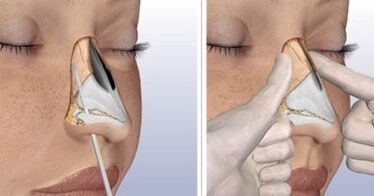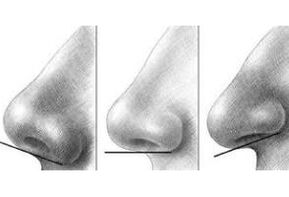
Rhinoplasty or rhinoplasty is a branch of plastic surgery that specializes in correcting congenital or acquired defects, as well as restoring individual segments of the nose or entire organs.
Rhinoplasty surgery can increase or decrease the size of the nose, change its shape and eliminate respiratory problems. The aesthetic goal of rhinoplasty is to achieve harmony in facial features by correcting defects in the nose. As a rule, this type of operation is performed when reaching the age of 18-21, because up to this time there is a physiological growth of bone and cartilage tissue.
The job of rhinoplasty is to restore the correct shape and function of the nose, which is affected by injury or during the period of embryogenesis. Rhinoplasty is a variety of different operations, which will be discussed in more detail below.
The Israeli clinic provided excellent results, the medical treatment provided met the patient’s expectations.
During rhinoplasty in Israel, open or closed access may be used, depending on the purpose of the operation. With closed rhinoplasty, an incision is made in the cavity, the skin peeling off the skeleton (cartilage and nose). This method is used to change the shape, remove excess cartilage and bone, and others. If a large number of surgeries are planned, open nasal rhinoplasty is prescribed when an incision is made in the columella (the vertical fold of skin that separates the nostrils).
Nasal correction is divided into primary and secondary. Secondary plastic surgery or surgery is performed to remove defects that remain after primary surgery.
In recent years, fillers have been actively used in rhinoplasty if necessary to correct small imperfections of the nose: changing the shape of the wings, restoring symmetry, rounding the tip of the nose, etc.
Rhinoplasty surgery in Israel: planning and implementation

At an Israeli clinic, a patient is first referred by a plastic surgeon, he or she examines the shape of the nose, the condition of the tissues, and diagnoses nasal breathing disorders. To get the best cosmetic results, pictures and computer models of the nose were taken. The patient was also referred by an ENT physician. If there is an obvious defect, when nasal breathing is interrupted, nasal rhinoplasty is performed in conjunction with an otolaryngologist and a plastic surgeon.
As a rule, during surgery, general anesthesia is used in combination with local infiltration anesthesia. The duration of rhinoplasty depends on the complexity and takes 1-2 hours or more. To give the nose a more aesthetic size and shape, surgeons change the skeleton and cartilage. Properly performed rhinoplasty in Israel and the absence of complications - and the scars after the surgery will actually not be visible.
Recovery period after nasal correction
After surgery, a tampon is installed in the nasal passages, it is removed after 2-3 days. To repair the new shape, a special plaster or colloidal adhesive is applied for five to seven days (if the plastic touches the cartilage part of the nose) or for twelve to fourteen days (if the bone part).
As a result of the swelling, nasal breathing can be difficult in the first week. The bruising and swelling disappeared within ten to fourteen days. It is not recommended to wear glasses for one and a half months after nose correction. The full rehabilitation course takes six to eight months, then the final results of the operation will be visible. Smoking and taking certain medications can delay recovery.
Rhinoplasty in Israel: removal of nasal bumps

The operation is multi -stage. In the process of its implementation, the osteocartilaginous protrusion of the back of the nose is eliminated. The hunchback can be caused by trauma or hereditary factors.
If the nasal hump is small, local anesthesia can be used, if large - general. The duration of the surgical intervention is 1-2 hours.
First, the surgeon dissects and removes the skin from the base of the nasal cartilage - the skeletal stage. Thereafter, the cartilage is cut and the cartilaginous segment of the septum is removed gradually, starting from the smallest volume. Then the nasal hump component is cut.
After the hump was removed, the pyramid -shaped skeleton was cut off. Osteotomy is performed to unite the nasal bones and remove the broad platform. The surgeon dissects the lateral slope bone tissue and brings it closer to the upper segment. To eliminate the irregularities, he used contour plastic using the patient’s own cartilage or various implants. At the end of the nasal correction, a cotton swab is placed in the nasal passage, and a plaster cast is applied to fix the new position of the tissue. The plaster is removed after eight to ten days.
For several weeks after the removal of the nasal hump, bleeding and swelling in the nasal area persisted. When edema subsides, nasal breathing is restored. The final result of the operation can be assessed in six months, when the tissue is fully restored.
Nasal septoplasty in Israel

This is surgery to correct the nasal septum while preserving the skeleton of bone and cartilage. This type of plastic allows you to achieve aesthetic results and eliminate breathing difficulties.
The nasal septum is a thin vertical bone and cartilage plate, which is easily deformed, leading to impaired respiratory function and deterioration of aesthetic appearance. The reason may be an injury, rickets suffered in childhood, hereditary predisposition.
Contraindications are:
- severe pathology of internal organs;
- oncology;
- contagious disease;
- problems with blood clotting;
- diabetes.
Indications for nasal septoplasty:
- allergic pathology (itching, runny nose, etc. );
- nasal breathing difficulties and its absence;
- chronic and acute diseases of the paranasal sinuses (frontitis, ethmoiditis, sinusitis);
- vasomotor rhinitis and frequent nasal bleeding;
- snoring due to impaired nasal breathing, etc.
In cases of exacerbation, septoplasty is performed two weeks after its removal. Indications for surgery in Israel are determined by an otolaryngologist based on history and diagnosis (rhinoscopy). Before surgery, laboratory tests, ECG, X-ray of the lungs are performed.
As a painkiller, infiltration anesthesia can be used (with the help of an injection it is injected into the nasal septum), local application anesthesia (turundas infused with anesthetic injected into the nasal passages), as well as general anesthesia.
With septoplasty in Israel, surgeons make incisions in the nose or endonasal, as a result, no postoperative scars are visible. On both sides of the nasal septum, it exfoliates the mucous membranes, highlighting and removing the curved parts of the rectangular bone and cartilage structure of the septum. Upon completion of the nasal correction, sutures are applied and tamponade is performed with fingers or gauze. A sling -like bandage is applied to the nose.
Also, septoplasty in Israel is performed using endoscopic access. An endoscope with optical fibers is inserted into the nasal cavity, which allows you to see hard -to -reach departments on the monitor and perform the operation as correctly as possible. This type of nasal septoplasty provides minimal damage to cartilage and tissues, reducing the recovery period.
In addition, laser septoplasty is used in Israeli clinics, thanks to which the development of bleeding and edema can be prevented, because the laser "seals" the vessel by cutting the tissue. In addition, it provides an antiseptic effect.
The duration of septoplasty is determined by the degree of curvature of the septum, the operation can last from thirty minutes to one and a half hours.
This type of rhinoplasty is relatively easy to accept. The patient was in the hospital until the nasal swab was removed. Ten to fourteen days is enough to restore working capacity, full recovery takes about a month.
Rhinoplasty in Israel: the convergence of the nasal bone
Osteotomy in Israel (bone repositioning, bone aggregation) can be an independent operation that corrects the shape of the nose, or one of the steps to remove a nasal lump. Thanks to this type of plastic surgery, surgeons achieve the ideal proportions of the nose to the proportions of the face, reducing the lateral bones of the nasal stem.
In the process of osteotomy, it unites the walls of the bone pyramid, after which the cartilage attached to the bone moves. The skin, as a rule, without much difficulty adapts to changes in the contours of the back of the nose.
Of the total time of rhinoplasty, osteotomy takes a few minutes. Upon completion of the correction, the nose is sealed with a surgical plaster and fitted with a bandage to maintain its shape and protect it from damage.
Within 2 weeks, the hematoma and edema disappeared. New contours are finally formed within a year.
Rhinoplasty in Israel: nasal tip support

Support for the tip of the nose is provided by a stable, strong and correct arrangement of cartilage. Usually, they are slightly above or below the line that runs along the back of the nose.
Inadequate support is caused by the unintended consequences of rhinoplasty (when adequate support is not provided) or the process of age -related tissue ptosis (ligaments that support cartilage are weakened).
To create support, the entire outer nose is shaped proportionally and correctly. The norm is the nasolabial angle (formed by the upper lip and columella) - 90-120 °.
During rhinoplasty in Israel, the tip of the nose can be raised seven to eight millimeters above the posterior profile line. The tip skin has difficulty adapting to change because it is less elastic and thicker.
To restore support, transplanted cartilage grafts - "props" can be used. The surgeon places such cartilage between the lateral cartilage and corrects it, then cuts it to the desired size.
Also, the end graft can be placed perpendicular to the support, on the cartilage. This option is used when the cartilage of the tip of the nose is damaged and is not used for self -support. A suitable source for grafting is cartilage from the nasal septum.
If it is not possible to obtain a graft from the end, the cartilage can be taken from the pinna. However, it is considered not strong enough to withstand stress and shape. Therefore, often the ear cartilage is connected to the nasal septum of a strong and thin bone. Part of the bone is attached to the cartilage graft.
Rhinoplasty in Israel: shortening the nose
Nasal removal is a plastic surgery that reduces the length of the outer nose. Often, the length of the septal cartilage is reduced, in more rare cases, the lateral wall of the nose, which is formed by large alar, triangular cartilage and bone.
Various methods are used to estimate the length of the nose. The most common method is to measure the distance from the tip of the nose to the bridge of the nose. Another method involves the determination of the magnitude of the nasolabial angle.
As we get older, the ligaments that hold the cartilage weaker, the tip of the nose falls off and visually increases in length. For this reason, in adulthood, patients shorten the length of the nose less than in young people.
The type of surgery in Israel that shortens the nose
With a long nose, as a rule, the cartilage and bone parts of the nose, the triangular and alar cartilage in the transverse and longitudinal directions, and the cartilage part of the septum are usually equal. As a result, either surgery is performed that shortens the lateral cartilage wall of the nose, or resection of the distal septum cartilage.
In the second option, partial resection is performed using infiltration anesthesia. The surgeon performed 2 parallel incisions of the transplant, in which he removed the cartilaginous septa from the mucosa and the excise skin strip in the columella area. Then the slices are sewn with catgut thread. As a result, the nose is shortened and the nasolabial angle is increased.
Another way is to increase the nasolabial angle by placing silicone or a cartilage liner in front of the maxillary spine.
Rhinoplasty in Israel: correction of the tip of the nose

This type of rhinoplasty in Israel can be done in several ways. The operation is performed on the terminal part of the outer nose: its shape is improved by removing the deformed or excessive part of the cartilage tissue, and a new position is fixed.
Correction of the tip of the nose is a complex aspect of rhinoplasty, the task of which is to restore the harmonious anatomical properties without disturbing the supporting structure of the organ.
Due to the variety of options for correcting the tip of the nose, individual rhinoplasty plans in Israel were developed, which took into account the strength and shape of cartilage, skin thickness, width and length of the nose, nasolabial angle, vault angle anatomy, back contour and the patient’s own wishes.
To narrow the tip of the nose, the surgeon cuts a segment of the alar cartilage and removes part of the fatty tissue. Variants can be used, in which the dome is dissected and sutures are applied, narrowing or connecting them to each other.
Rhinoplasty in Israel: repositioning of a broken nose
Surgery to correct this nose involves restoring the missing bone fragment to its normal position. The optimal time for this plasty is the first hour after the fracture, until soft tissue edema develops, or the next 3-7 days, when the edematous condition subsides. 10 days after injury, calluses form, so relocation can no longer be done.
Forty percent of all facial injury cases are nasal fractures, caused by sports injuries, street and domestic fights, road accidents, falls. Such fractures can be closed and open, without displacement and with displacement of bone fragments. Symptoms of fractures include external nasal deformities, swelling, pain, mucus mucus, bleeding, wounds, abrasions, bloody nose due to rupture of the mucous membranes. Moreover, the sense of smell and nasal breathing are impaired.
For diagnostic purposes in Israel, patients are interviewed, they can perform external and endonasal examinations, endoscopic examination, radiography of the nasal bone.
A relatively common consequence of a fracture is curvature of the nasal septum, which is accompanied by recurrent sinusitis, rhinitis, and nasal respiratory disorders. Correction of curvature can only be done through surgery.
Other complications may be hematoma of the nasal septum below the mucous membrane, it narrows the lumen of the nasal passages and makes breathing difficult. Probably suppuration and subsequent cartilage destruction. Therefore, high quality and immediate medical care for nasal fractures is extremely important.
Cold (ice or cold compresses) can be used as a first step to reduce swelling and pain as well as stop bleeding.
In Israeli clinics, plastic surgeons perform fracture repositioning. During the first 6-7 days, repositioning is performed using manual local anesthesia so that the bones grow together properly in the future. Tight tamponade on the cavity with a downhill is performed to press and support the nasal skeleton. Bandages are used on the outside.
Self -reduction is strictly prohibited due to additional trauma. After the swelling subsided, the aesthetic and respiratory functions of the nose were assessed. Fractures can cause deformation of the osteocartilaginous part of the nose and lateral displacement, narrowing of the nasal passages, curvature of the septum, etc.
If the nasal bones do not grow together properly, patients often have to turn to rhinoplasty. To restore the respiratory disorder, the deviated septum is corrected - rhinoseptoplasty is performed.
Rhinoplasty in Israel: nasal wing correction

This type of operation is performed to change the width, thickness and symmetry in the presence of obvious aesthetic defects and deformities. Various methods are used depending on the violation. For repair, the tissue around the defect is mobilized or cartilage or skin grafts are mobilized.
Nasal wing correction can be an independent operation or the final stage of rhinoplasty in Israel.
Nasal wing defects are acquired and are congenital, complete or partial. The reason is as a result of nasal correction or removal of tumors, trauma, burns and disease.
Most surgeries to correct nasal wings are performed using local infiltration anesthesia. If there is widespread defect, intravenous anesthesia is used.
Sometimes a plasty tip is used to correct the nasal wings. In this case, the operation complements the rhinoplasty. If aesthetic defects are noted, correction is carried out during the main phase of operation.
When necessary to reduce the distance between the wings of the nose, incisions are made at the base of the wings from the vestibule and along the contour. Skin and mucosal segments were cut, hemostasis was performed, and sutures were used. Scars are placed in the folds of the nasal wings and the natural nasolabial folds, making them almost invisible.
If necessary to restore nasal wing support (in case of retraction or injury), neighboring tissue areas are removed, the skin flap or cartilage itself is removed from the auricle or nasal septum, specially modeled.
The recovery period can last five days, in the case of cartilage reconstruction - seven or more.
Rhinoplasty in Israel: complete nasal correction
This type of rhinoplasty in Israel involves complex rhinoplasty, which is performed in a segment of the outer nasal structure and in the thickness of the organ tissue. They can reduce the length of the nose, change its shape, remove the hump, narrow the width of the back, adjust the tip. Along with plasty, they restore the normal respiratory function and architecture of the cavity.
Often, this surgery is performed after an injury.
In most cases, correction is performed through a closed (endonasal) approach, excluding external skin incisions. Superficial manipulation can be performed using local anesthesia and intravenous sedation, surgery on internal structures requiring general anesthesia. This nasal correction is possible in the age group - 18-40 years.
Rhinoplasty in Israel can be combined with the following plastic surgeries: blepharoplasty, facelift, chin and lip surgery, liposuction, breast lift, etc.
Prior to surgery, the anatomical structure of the nose is carefully analyzed and its future shape is modeled on a computer. In case of violation of nasal breathing, the nasal cavity is examined, radiography or tomography is performed.
Modern rhinoplasty in Israel uses economical techniques that provide excellent results and minimize the possibility of complications.




















